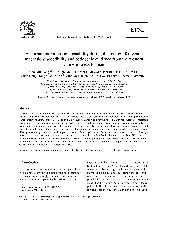摘要
The 28 m high-resolution Shajinping loess section in Lanzhou on the western Chinese Loess Plateau records a 60 ka, millennial summer monsoon variation. The record shows that Asian summer monsoons have rapid episodic pulse enhancements spanning only ca. 1-2 ka in high-frequency domain and having sub-Milankovitch cycles of progressive weakening in low frequency domain in the last glaciation. Soil formation seems to occur with a surprisingly fast response to these summer monsoon enhancements, resulting in weakly or moderately developed paleosol sequences. Both the pattern and timing of the summer monsoon enhancements show that they can be correlated to most major warm (Dansgaard-Oeschger) episodes and long-term cooling (Bond) cycles of the North Atlantic climatic records, indicating a possible teleconnection between tropic oceanic air masses and the North Atlantic climatic system. But differences exist for the transition of MTS 2/3 and the Holocene, when extraordinarily heavy dust-input events and fairly variable climatic fluctuations occur for the former and latter, respectively. A westerlies-swing model is proposed to interpret this link.
- 出版日期1999-5-15
- 单位兰州大学
